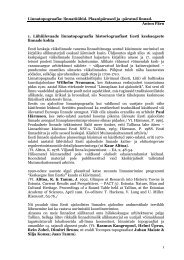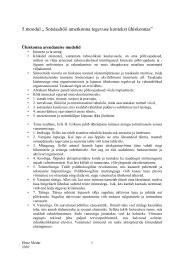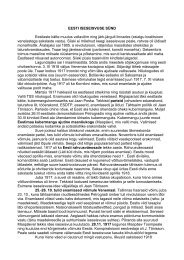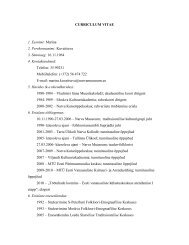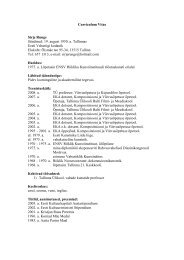crowding and children's mental health: the role of house type
crowding and children's mental health: the role of house type
crowding and children's mental health: the role of house type
Create successful ePaper yourself
Turn your PDF publications into a flip-book with our unique Google optimized e-Paper software.
Journal <strong>of</strong> Environ<strong>mental</strong> Psychology (2002) 22, 221^231<br />
0272-4944/02$-see front matter r 2002 Elsevier Science Ltd. All rights reserved.<br />
doi:10.1006/jevp.256, available online at http://www.idealibrary.com on<br />
CROWDING AND CHILDREN’S MENTAL HEALTH: THE ROLE OF HOUSE TYPE<br />
GARY W. EVANS 1 ,PETER LERCHER 2 AND WALTER W. KOFLER 2<br />
1 Design <strong>and</strong> Environ<strong>mental</strong> Analysis, Cornell University, Ithaca, NY 14853-4401, U.S.A.<br />
2 University <strong>of</strong> Innsbruck Institute for Hygiene <strong>and</strong> Social Medicine, Sonnenburg strasse 16<br />
A-6020 Innsbruck, Austria<br />
Abstract<br />
An important <strong>and</strong> largely unstudied aspect <strong>of</strong> <strong>the</strong> apparent relation between residential <strong>crowding</strong> <strong>and</strong> <strong>mental</strong><br />
<strong>health</strong> is <strong>the</strong> potential <strong>role</strong> <strong>of</strong> environ<strong>mental</strong> design to moderate this relation. An epidemiological investigation<br />
reveals that <strong>the</strong> <strong>type</strong> <strong>of</strong> housing children inhabit alters <strong>mental</strong> <strong>health</strong> correlates <strong>of</strong> residential <strong>crowding</strong>.<br />
Third <strong>and</strong> fourth grade Austrian children (n=1,236) from small towns <strong>and</strong> agricultural areas who reside in<br />
multiple family dwellings manifest signi¢cantly stronger associations between residential density <strong>and</strong> a st<strong>and</strong>ardized<br />
self-report index <strong>of</strong> psychological <strong>health</strong> (KINDL) as well as teacher ratings <strong>of</strong> behavioral conduct in<br />
<strong>the</strong> classroom (Needleman) in comparison to <strong>the</strong>ir counterparts residing ei<strong>the</strong>r in single family detached<br />
homes or in row <strong>house</strong>s. These ¢ndings occur independently <strong>of</strong> mo<strong>the</strong>r’s educational level among children<br />
residing in relatively low-density housing.<br />
# 2002 Elsevier Science Ltd. All rights reserved.<br />
Most research on <strong>crowding</strong> <strong>and</strong> <strong>mental</strong><strong>health</strong> has<br />
attempted to uncover direct relations between<br />
<strong>house</strong>hold density <strong>and</strong> various indices <strong>of</strong> psychological<br />
well being. Generally, <strong>the</strong>re is good support for<br />
<strong>the</strong> claim that higher levels <strong>of</strong> interior residential<br />
density (people per room) are associated with elevated<br />
levels <strong>of</strong> psychological distress among adults<br />
(Marsella et al., 1970; Hassen, 1977; Gove & Hughes,<br />
1983; Gabe & Williams, 1987; Jain, 1987; Evans et al.,<br />
1989; Edwards et al., 1990; Lepore et al., 1991).The<br />
Lepore et al. (1991) study is especially noteworthy<br />
because it provides he only prospective, longitudinalevidence<br />
for <strong>the</strong> linkage between <strong>crowding</strong> <strong>and</strong><br />
<strong>mental</strong><strong>health</strong>. At initialoccupancy, residents <strong>of</strong><br />
more crowded homes did not di¡er from <strong>the</strong>ir less<br />
crowded counterparts in psychological distress.<br />
However, at two months occupancy <strong>the</strong>re was such<br />
a relationship, <strong>and</strong> by eight months <strong>the</strong> strength <strong>of</strong><br />
<strong>the</strong> association had grown stronger. This pattern <strong>of</strong><br />
results argues against a social drift or downwards<br />
mobility explanation for <strong>the</strong> <strong>crowding</strong>F<strong>mental</strong><br />
<strong>health</strong> association. Residential <strong>crowding</strong> appears to<br />
lead to psychological distress <strong>and</strong> not <strong>the</strong> o<strong>the</strong>r way<br />
around.<br />
Although <strong>the</strong>re is less evidence for <strong>the</strong> <strong>mental</strong><br />
<strong>health</strong> sequelae <strong>of</strong> residential <strong>crowding</strong> among children,<br />
indirect data exist. Children in higher density<br />
homes experience greater corporalpunishment<br />
(Booth & Edwards, 1976), higher levels <strong>of</strong> con£ict<br />
with family members (Booth & Edwards, 1976; Saegert,<br />
1982; Evans et al., 1998) <strong>and</strong> reduced parental<br />
responsiveness (Bradley & Caldwell, 1984; Wachs,<br />
1989; Evans et al., 1999). Given <strong>the</strong>se impairments<br />
in criticalparent^child proximalprocesses (Bronfenbrenner<br />
& Morris, 1998), it is not surprising that<br />
children from higher density homes manifest more<br />
behavioraladjustment di⁄culties at school(Booth<br />
& Johnson, 1975; Saegert, 1982; Evans et al., 1998).<br />
An important <strong>and</strong> largely unstudied aspect <strong>of</strong> <strong>the</strong><br />
apparent relation between <strong>house</strong>hold <strong>crowding</strong> <strong>and</strong><br />
psychological distress is <strong>the</strong> potential <strong>role</strong> <strong>of</strong> environ<strong>mental</strong>design<br />
to moderate this association (Aiello<br />
& Baum, 1979; Ineichen, 1993). What <strong>role</strong> might<br />
interior design or architecturalvariables play in altering<br />
<strong>the</strong> nature <strong>of</strong> <strong>the</strong> relations between <strong>house</strong>hold<br />
<strong>crowding</strong> <strong>and</strong> <strong>mental</strong> <strong>health</strong>? This study<br />
examines whe<strong>the</strong>r typicalvariations in housing<br />
<strong>type</strong>, speci¢cally single family, row <strong>house</strong>, or multiple<br />
unit dwellings, make any di¡erence in how children<br />
respond to residential<strong>crowding</strong>. There is some<br />
indirect evidence in <strong>the</strong> <strong>crowding</strong> literature to expect<br />
that <strong>the</strong> latter housing <strong>type</strong>, multiple family
222 G. W. Evans et al.<br />
dwellings, might exacerbate negative impacts <strong>of</strong> residential<strong>crowding</strong><br />
on children’s psychologicalwell<br />
being.<br />
One <strong>of</strong> <strong>the</strong> major underlying psychological processes<br />
that appears to account for some <strong>of</strong> <strong>the</strong> negative<br />
e¡ects <strong>of</strong> <strong>crowding</strong> is loss <strong>of</strong> control over<br />
interpersonalinteraction (Altman, 1975; Saegert,<br />
1982). Too much unwanted socialinteraction is a frequent<br />
concommitent <strong>of</strong> <strong>crowding</strong> (Baum & Valins,<br />
1977, 1979; Mc Carthy & Saegert, 1979). When interior<br />
spaces are designed to foster better regulation <strong>of</strong><br />
interpersonalcontact, residentialdensity seems to<br />
have less negative impact. Baum <strong>and</strong> colleagues in<br />
a series <strong>of</strong> studies have shown that long corridor<br />
dormitory designs in comparison to ei<strong>the</strong>r suites or<br />
short corridor designs caused elevated <strong>crowding</strong><br />
<strong>and</strong> greater problems with <strong>the</strong> regulation <strong>of</strong> social<br />
interaction (Baum & Valins, 1977, 1979). Follow-up<br />
research revealed that when longer corridor dormitories<br />
were redesigned so that <strong>the</strong> number <strong>of</strong> residents<br />
sharing a common corridor was reduced, <strong>the</strong><br />
negative <strong>crowding</strong> e¡ects were attenuated (Baum &<br />
Davis, 1980). It is important to note that <strong>the</strong> students<br />
in Baum’s studies did not choose <strong>the</strong>ir housing<br />
accomodations. Cox et al. (1982) <strong>and</strong> Schae¡er et al.<br />
(1988) found that redesigning prison sleeping areas<br />
to enable better regulation <strong>of</strong> social interaction reduced<br />
<strong>crowding</strong>, improved physical<strong>health</strong>, <strong>and</strong> lowered<br />
both psychophysiological <strong>and</strong> self-reported<br />
stress. Floorplan con¢gurations that a¡ord greater<br />
opportunity for being alone also attenuate <strong>the</strong> negative<br />
impacts <strong>of</strong> residentialdensity on psychological<br />
well being. Evans et al. (1996) used spatialsyntax<br />
analysis to quantify residential £oorplans among<br />
o¡ campus student housing units. Floorplans with<br />
greater depth bu¡ered <strong>the</strong> <strong>crowding</strong>^distress relationship.<br />
Depth is a measure <strong>of</strong> <strong>the</strong> degree <strong>of</strong> separation<br />
between di¡erent spaces within a<br />
£oorplan con¢guration <strong>and</strong> predicts social interaction<br />
(Hillier & Hanson, 1984).<br />
Residentialdesign can also make a di¡erence in<br />
how children respond to <strong>crowding</strong>. Wachs <strong>and</strong><br />
Gruen (1982) found that preschoolchildren in more<br />
crowded homes manifested delayed cognitive development.<br />
Both cross-sectional<strong>and</strong> longitudinalevidence<br />
re£ected this trend. Interestingly if <strong>the</strong>se<br />
children had access to a room where <strong>the</strong>y could<br />
spend time alone, <strong>the</strong> negative develop<strong>mental</strong> correlates<br />
<strong>of</strong> residential <strong>crowding</strong> were diminished.<br />
There is also evidence that when children live in<br />
larger, multiple family dwelling complexes, emotional<br />
well being may be a¡ected. Children living<br />
in high-rise, multiple dwelling complexes have higher<br />
rates <strong>of</strong> behavioralproblems in comparison to<br />
those residing in single-family homes or smaller,<br />
low-rise buildings (Ineichen & Hooper, 1974; Richman,<br />
1977; Saegert, 1982). Rates <strong>of</strong> juvenile delinquency<br />
are also higher among adolescents in<br />
multiple dwelling units relative to those in single-family<br />
detached homes (Gillis, 1974). Of particular relevance<br />
to <strong>the</strong> present study, <strong>the</strong> major hypo<strong>the</strong>sis<br />
o¡erred to account for <strong>the</strong> apparent covariation between<br />
housing <strong>type</strong> <strong>and</strong> children’s psychological distress<br />
is <strong>the</strong> relative inaccessibility to playspaces<br />
externalto <strong>the</strong> residence. This in turn is believed<br />
to lead to young children being cooped up inside<br />
with more intra-family con£ict <strong>and</strong> greater social<br />
isolation from peers (Halpern, 1995; Evans et al., in<br />
press; Gi¡ord, in press).<br />
In <strong>the</strong> present study, we were able to take advantage<br />
<strong>of</strong> an epidemiological study on environ<strong>mental</strong><br />
quality <strong>and</strong> children’s well being conducted in small<br />
towns <strong>and</strong> ruralareas in <strong>the</strong> Nor<strong>the</strong>rn TirolRegion<br />
<strong>of</strong> Austria, proximate to Innsbruck. Included in <strong>the</strong><br />
study protocolwere measures <strong>of</strong> residentialdensity<br />
(people per room), housing <strong>type</strong> (single-family, row<br />
<strong>house</strong>, multiple dwelling unit) <strong>and</strong> two indices <strong>of</strong><br />
<strong>mental</strong><strong>health</strong>. Based upon prior research on <strong>crowding</strong><br />
<strong>and</strong> architecture as well as on housing, we hypo<strong>the</strong>sized<br />
that elementary school children living<br />
in high-density homes in multiple dwelling complexes<br />
would su¡er greater psychological distress<br />
than those living in crowded homes that were ei<strong>the</strong>r<br />
single-family detached or row <strong>house</strong>s. Thus, we predicted<br />
an interaction between density <strong>and</strong> <strong>house</strong><br />
<strong>type</strong> on <strong>mental</strong><strong>health</strong>. Ano<strong>the</strong>r facet <strong>of</strong> this study<br />
warrants brief comment. Unlike previous psychologicalstudies<br />
<strong>of</strong> <strong>crowding</strong>, <strong>the</strong> data set is large, consisting<br />
<strong>of</strong> nearly 1300 children. This also enabled us<br />
to generate a dose^response function, examining<br />
variability in <strong>mental</strong> <strong>health</strong> over a range <strong>of</strong> residentialdensities<br />
typicalfor this region <strong>of</strong> Austria <strong>and</strong><br />
probably for much <strong>of</strong> non-urban, Western European.<br />
To our knowledge, no dose^response data currently<br />
exist on residentialdensity <strong>and</strong> <strong>mental</strong><strong>health</strong>.<br />
Participants<br />
Method<br />
One thous<strong>and</strong> two hundred <strong>and</strong> eighty children in<br />
grades 3^4 (M=9?44 years) were recruited by letters<br />
sent to families living in <strong>the</strong> Inn Valley <strong>of</strong> Tyrol in<br />
Austria. This age group was chosen to correspond to<br />
severalo<strong>the</strong>r studies <strong>of</strong> environ<strong>mental</strong>quality <strong>and</strong><br />
children’s <strong>health</strong> (Wohlwill & Heft, 1987; Evans et<br />
al., 1991; Evans, 2000). The response rate was 79.5%.
This area consists <strong>of</strong> small towns <strong>and</strong> villages with<br />
a mix <strong>of</strong> industrial<strong>and</strong> agriculturalactivities in<br />
ruralareas outside <strong>of</strong> Innsbruck. About one-third<br />
<strong>of</strong> <strong>the</strong> sample lives in communities with approximately<br />
6000 inhabitants, 50% in villages at half this<br />
size, <strong>and</strong> <strong>the</strong> remaining families in small villages<br />
<strong>and</strong> scattered sites. Fifty-one percent <strong>of</strong> <strong>the</strong> children<br />
were boys. Maternaleducation was coded<br />
along a continuum: basic education (9 years) (26%),<br />
additional2 years <strong>of</strong> technical/trade school(33%),<br />
additional4 years <strong>of</strong> university preparatory school<br />
(24%), or college/graduate education (15%), <strong>and</strong> 2%<br />
not reported. Twenty-seven percent <strong>of</strong> <strong>the</strong> mo<strong>the</strong>rs<br />
are white collar workers or civil servants, 51% are<br />
homemakers, 11% self-employed, <strong>and</strong> 9% unskilled<br />
laborers. Of <strong>the</strong> 1154 families with complete data<br />
on density <strong>and</strong> <strong>house</strong> <strong>type</strong>, 55% <strong>of</strong> <strong>the</strong> sample lived<br />
in single-family, detached homes, 17% in row <strong>house</strong>s,<br />
<strong>and</strong> 21% in multiple family dwellings.<br />
Procedure<br />
The data presented here are only a small portion<br />
<strong>of</strong> a larger investigation <strong>of</strong> environ<strong>mental</strong> quality<br />
Crowding <strong>and</strong> Children’s Mental Health 223<br />
<strong>and</strong> <strong>health</strong> conducted by <strong>the</strong> School <strong>of</strong> Medicine,<br />
University <strong>of</strong> Innsbruck <strong>and</strong> <strong>the</strong> Austrian Ministry<br />
<strong>of</strong> Transportation in ruralareas in Austria. Results<br />
are reported for <strong>the</strong> entire sample from <strong>the</strong> environ<strong>mental</strong><br />
quality <strong>and</strong> <strong>health</strong> study. In addition to noise<br />
<strong>and</strong> air pollution exposure information, each child’s<br />
<strong>house</strong> was classi¢ed as single-family, row <strong>house</strong>, or<br />
multiple dwelling unit. Detached homes (see Figure<br />
1a) are occupied by one or two (10%) families. They<br />
are more physically separated from o<strong>the</strong>r <strong>house</strong>s relative<br />
to <strong>the</strong> o<strong>the</strong>r two housing categories <strong>and</strong> <strong>of</strong>ten<br />
(95%) have garden spaces in between <strong>the</strong>m <strong>and</strong><br />
o<strong>the</strong>r units. Row <strong>house</strong>s (Figure 1b) include attached<br />
<strong>house</strong>s <strong>of</strong> three to eight units, typically inhabited<br />
by one family. Most row <strong>house</strong>s (82%) have<br />
proximate garden spaces, but <strong>the</strong> grounds are not as<br />
spacious as typically encountered among detached<br />
homes. Multiple dwelling family units (Figure 1c)<br />
are larger buildings holding from three to 25 dwelling<br />
units. The highest buildings are 10 stories high<br />
but 95% have four £oors or less. Only 27% <strong>of</strong> apartments<br />
have adjacent garden spaces but most share<br />
common grounds (65%), <strong>of</strong>ten incorporating a play<br />
area for children. As indicated below, <strong>house</strong> <strong>type</strong> is<br />
FIGURE 1. Illustrations <strong>of</strong> <strong>the</strong> three <strong>type</strong>s <strong>of</strong> housing categories: detached, row <strong>house</strong> <strong>and</strong> multiple dwelling units
224 G. W. Evans et al.<br />
FIGURE 2. Photograph <strong>of</strong> typicalliving conditions in <strong>the</strong> lower Inn<br />
valley in Austria<br />
unrelated to social class (mo<strong>the</strong>r’s education or occupationalcategory).<br />
Figure 2 depicts a typicalcommunity<br />
in <strong>the</strong> area sampled <strong>and</strong> also illustrates<br />
generalliving conditions.<br />
Density was determined by dividing <strong>the</strong> number<br />
<strong>of</strong> people living in <strong>the</strong> residence by <strong>the</strong> number <strong>of</strong><br />
rooms in <strong>the</strong> home. Bathrooms, storage areas, garages,<br />
<strong>and</strong> hallways were not counted.<br />
Two measures <strong>of</strong> children’s psychological well<br />
being from <strong>the</strong> larger environment <strong>and</strong> <strong>health</strong> study<br />
are included here. All information was in German<br />
<strong>and</strong> collected by two experimenters (university students).<br />
The ¢rst measure consists <strong>of</strong> two subscales <strong>of</strong><br />
<strong>the</strong> KINDL (Bullinger et al., 1994) which is an index<br />
<strong>of</strong> quality <strong>of</strong> life designed for elementary-aged<br />
schoolchildren in Germany. Extensive psychometric<br />
documentation is available for this scale, including<br />
one week test, re-test reliabilities exceeding 0?90,<br />
measures <strong>of</strong> internalconsistency about 0?80, <strong>and</strong><br />
both convergent (e.g. midrange correlations between<br />
0?39 <strong>and</strong> 0?46 with severalo<strong>the</strong>r longer indices <strong>of</strong><br />
nonspeci¢c psychological <strong>health</strong> in children as described<br />
by <strong>the</strong> authors <strong>of</strong> <strong>the</strong> KINDLFsee below)<br />
<strong>and</strong> discriminant validity (e.g. children with high<br />
stressfullife events or those exposed to greater,<br />
chronic environ<strong>mental</strong>stressors manifest signi¢cantly<br />
lower KINDL scores). Fur<strong>the</strong>rmore, <strong>the</strong><br />
KINDL is unrelated to school <strong>type</strong> (private vs public)<br />
or speci¢c diseases (i.e. asthma vs diabetes) but<br />
is sensitive to children with <strong>and</strong> without chronic illness<br />
(Bullinger et al., 1994; Bullinger & Ravens-Sieberer,<br />
1995; Ravens-Sieberer & Bullinger, 1998). We<br />
combined <strong>the</strong> emotionalwe l-being scale <strong>and</strong> <strong>the</strong><br />
functionalimpairment scale because <strong>the</strong>y were<br />
highly correlated (r =0?63) <strong>and</strong> formed an internally<br />
consistent scale (a = 0?81). Fur<strong>the</strong>rmore, our<br />
data closely match subscale intercorrelations for<br />
<strong>the</strong> KINDL as reported by Bullinger <strong>and</strong> colleagues<br />
(e.g. 0?64^0?67). Scores ranged from 0 = never, 1 =<br />
rarely, 2 = sometimes, 3 = <strong>of</strong>ten to 4 = very <strong>of</strong>ten,<br />
with a higher score indicating higher quality <strong>of</strong> life.<br />
Children were administered <strong>the</strong> KINDL in writing<br />
in <strong>the</strong>ir own classroom with careful supervision to<br />
insure that each child responded independently to<br />
<strong>the</strong> questionnaire.<br />
The second scale was given to each child’s teacher<br />
<strong>and</strong> consisted <strong>of</strong> 11 yes/no questions about behavioralconduct<br />
in <strong>the</strong> classroom. This scale was originally<br />
developed by Needleman to measure classroom<br />
behaviors in relation to low-level ambient lead exposure<br />
in elementary school children (Needleman et al.,<br />
1979; Needleman, 1983). The scale has been shown to<br />
be sensitive to very small changes in lead levels both<br />
cross sectionally (Needleman et al., 1979; Yule et al.,<br />
1981; Needleman, 1983; Winneke et al., 1990) <strong>and</strong><br />
longitudinally from elementary school to high school<br />
(Needleman et al., 1990). The Winneke study included<br />
primary schoolsamples from eight European countries,<br />
including Germany. The 11 item scale was reliable<br />
(a =0?80). No prior data on scale reliability are<br />
available. Higher scores indicated better functioning<br />
in <strong>the</strong> classroom. The compiled items from both<br />
scales are included in <strong>the</strong> Appendix 1 .<br />
Both teachers <strong>and</strong> experimenters were blind to<br />
<strong>the</strong> child’s home density levels <strong>and</strong> <strong>house</strong> <strong>type</strong> at<br />
<strong>the</strong> time <strong>of</strong> data collection. Children were informed<br />
that this was a study <strong>of</strong> tra⁄c, environment, <strong>and</strong><br />
<strong>health</strong>.<br />
Results<br />
Table 1 provides descriptive data <strong>and</strong> <strong>the</strong> intercorrelations<br />
among <strong>the</strong> two scales <strong>and</strong> <strong>the</strong> two subscales<br />
<strong>of</strong> <strong>the</strong> KINDL. These data indicate, as would be expected<br />
given our sample <strong>of</strong> working <strong>and</strong> middle<br />
class children, that overall levels <strong>of</strong> psychological<br />
distress as well as behavioral conduct problems are<br />
quite modest. The absolute levels are also comparable<br />
to those found for <strong>the</strong> KINDL with nonclinical<br />
samples <strong>of</strong> similar age (Bullinger et al., 1994; Bullinger<br />
& Ravens-Sieberer, 1995; Ravens-Sieberer & Bullinger,<br />
1998) Because Needleman <strong>and</strong> o<strong>the</strong>r<br />
investigators have used <strong>the</strong> Teacher Behavioral<br />
Questionnaire with younger children, we cannot directly<br />
compare our data to prior information on <strong>the</strong><br />
(Table 2).<br />
Figure 3 depicts <strong>the</strong> KINDL, psychological <strong>health</strong><br />
regression results. Plots are shown for <strong>the</strong> mean
Crowding <strong>and</strong> Children’s Mental Health 225<br />
TABLE 1<br />
Descriptive statistics <strong>and</strong> zero-order correlations<br />
Variable Mean SD 1 2 3 4<br />
1. Kindl3?08 0?56 0?31* 0?91** 0?90**<br />
2. Needleman 19?60 2?54 0?32* 0?24*<br />
3. Functional 3?05 0?63 0?64**<br />
impairment<br />
4. Emotional<br />
well being<br />
*po0?01.<br />
**po0?001.<br />
3?11 0?60<br />
TABLE 2<br />
Mean density levels (people/room) in relation to maternal<br />
education <strong>and</strong> <strong>house</strong> <strong>type</strong><br />
House <strong>type</strong><br />
Detached Row <strong>house</strong> Multiple<br />
dwelling<br />
Mo<strong>the</strong>r education<br />
Basic (9 years) 0?89 0?86 1?04<br />
Technical/trade 0?78 0?79 0?90<br />
University prep. 0?76 0?80 0?86<br />
University/graduate 0?79 0?85 0?86<br />
FIGURE 3. Regression <strong>of</strong> residentialdensity onto children’s self-reported<br />
<strong>mental</strong><strong>health</strong> as a function <strong>of</strong> housing <strong>type</strong><br />
level <strong>of</strong> density <strong>and</strong> one st<strong>and</strong>ard deviation above<br />
<strong>and</strong> below <strong>the</strong> mean for each <strong>of</strong> <strong>the</strong> three categories<br />
<strong>of</strong> housing, single-family detached, row <strong>house</strong>s, multiple<br />
unit dwellings. Housing <strong>type</strong> is a categorical<br />
variable <strong>and</strong> density continuous. The regression analyses<br />
employ dummy coding for <strong>the</strong> categorical term<br />
(Fisher & van Belle, 1993). As can be seen, <strong>the</strong> relation<br />
between density <strong>and</strong> psychological <strong>health</strong> is<br />
moderated by <strong>house</strong> <strong>type</strong>, F(2, 1148) = 3?31, p<br />
o0?05. For <strong>the</strong> interaction term, <strong>the</strong> increment in<br />
R 2 after partialling out mo<strong>the</strong>r’s education <strong>and</strong> both<br />
<strong>of</strong> <strong>the</strong> main e¡ects for <strong>house</strong> <strong>type</strong> <strong>and</strong> density is<br />
0.01. Tests <strong>of</strong> <strong>the</strong> simple slopes indicate that for single<br />
family <strong>house</strong>s, density is unrelated to <strong>the</strong><br />
KINDL, b = 0?06, t(1148) = 1?27 whereas for both<br />
row <strong>house</strong>s (b = 0?20, t(1148) = 2?09, po0?05) <strong>and</strong><br />
for multiple dwelling units (b = 0?36, t(1148) =<br />
3?07, po0?01) more <strong>house</strong>hold <strong>crowding</strong> is associated<br />
with diminished psychological <strong>health</strong>. There<br />
are also main e¡ects for density, DR 2 =0?05, F(1,<br />
1152) = 12?66, po0?01. Children living in more<br />
crowded homes report lower levels <strong>of</strong> psychological<br />
well being. There is also a main e¡ect for <strong>house</strong><br />
<strong>type</strong>, DR 2 = 0?02, F (2, 1151) = 3.47, po0?05. Post<br />
hoc comparisons reveal that children living in multiple<br />
family dwellings <strong>and</strong> row <strong>house</strong>s report lower<br />
levels <strong>of</strong> psychological well being than those residing<br />
in single-family detached homes. Because <strong>of</strong> <strong>the</strong><br />
naturalcovariation <strong>of</strong> density <strong>and</strong> maternaleducation<br />
(r = 0?14), all analyses statistically control<br />
for mo<strong>the</strong>r’s education. 1 Housing <strong>type</strong> is unrelated<br />
to mo<strong>the</strong>r’s education (w 2 o1?0). We also examined<br />
whe<strong>the</strong>r mo<strong>the</strong>r’s occupationalstatus was related<br />
to ei<strong>the</strong>r density or <strong>house</strong> <strong>type</strong> <strong>and</strong> found no systematic<br />
relations. For example whereas 14% <strong>of</strong><br />
mo<strong>the</strong>rs in multiple dwelling units are unskilled<br />
workers compared to 10% <strong>and</strong> 6% for row <strong>house</strong>s<br />
<strong>and</strong> detached homes, respectively, 24% <strong>of</strong> mo<strong>the</strong>rs<br />
in multiple dwelling units are white collar compared<br />
to 20% each for row <strong>house</strong>s <strong>and</strong> detached<br />
homes. The largest category, homemaker, indicated<br />
45% in multiple dwelling units, 55% in row <strong>house</strong>s,<br />
<strong>and</strong> 52% in detached homes. A similar, uninterpretable<br />
pattern <strong>of</strong> data were indicated for density <strong>and</strong><br />
mo<strong>the</strong>r’s occupationalstatus. For example, homemakers<br />
average density is 0?60, unskilled laborers<br />
0?52, <strong>and</strong> white collar 0?77. Exclusion <strong>of</strong> mo<strong>the</strong>r’s<br />
education as a statisticalcontrolhad little e¡ect<br />
on <strong>the</strong> results reported herein.<br />
As shown in Figure 4, similar interaction results<br />
were uncovered for <strong>the</strong> teacher ratings <strong>of</strong> behavioral<br />
disturbance in <strong>the</strong> classroom, F(2, 1093) = 3?33,<br />
po0?05, DR 2 =0?01. In this case, however, <strong>house</strong>hold<br />
<strong>crowding</strong> is correlated with behavioral disturbance<br />
only among those living in multiple-family dwellings,<br />
b = 1?54, t(1093) = 2?89, po0?01. Children in<br />
single family homes, b = 0?11, t(1093) o1?0 <strong>and</strong> in
226 G. W. Evans et al.<br />
FIGURE 4. Regression <strong>of</strong> residentialdensity onto teacher reports <strong>of</strong><br />
behavioralconduct in <strong>the</strong> classroom as a function <strong>of</strong> housing <strong>type</strong><br />
row <strong>house</strong>s, b = 0?63, t(1093) = 1?35, ns., do not<br />
manifest links between <strong>crowding</strong> <strong>and</strong> behavioral<br />
disturbances at school. Again <strong>the</strong>re are main e¡ects<br />
for density, F (1, 1097) = 5?16, po0?05, DR 2 =0?03 as<br />
well as for <strong>house</strong> <strong>type</strong>, F(2, 1096) = 3.96, po0?05,<br />
DR 2 = 0?01. Children from more crowded homes<br />
have greater levels <strong>of</strong> behavioral disturbance at<br />
school. Children living in multiple-family dwellings<br />
manifest greater behavioraldisturbances at school<br />
than those living ei<strong>the</strong>r in single family or row<br />
<strong>house</strong>s. As for <strong>the</strong> KINDL, all analyses statistically<br />
controlfor mo<strong>the</strong>r’s education.<br />
Discussion<br />
The data in Table 1 provide some evidence for concurrent<br />
validity <strong>of</strong> <strong>the</strong> two indexes <strong>of</strong> children’s psychological<br />
well being, given <strong>the</strong> correlation <strong>of</strong> 0?31<br />
between <strong>the</strong> Needleman scale which is a teacher<br />
rating scale <strong>of</strong> conduct disorder <strong>and</strong> <strong>the</strong> child’s selfreport<br />
(KINDL) <strong>of</strong> emotionalwellbeing <strong>and</strong> functional<br />
impairment. Ideally, one would prefer a higher<br />
degree <strong>of</strong> convergent validation, although <strong>the</strong><br />
level <strong>of</strong> correlation is well in line with expert ratings<br />
<strong>and</strong> middle elementary school children’s self-reports<br />
<strong>of</strong> psychological <strong>health</strong> (Wachs, 1989). Our<br />
degree <strong>of</strong> convergent validity also compares well to<br />
that obtained by <strong>the</strong> originalauthors <strong>of</strong> <strong>the</strong> KINDL<br />
with o<strong>the</strong>r generalassessments <strong>of</strong> children’s <strong>mental</strong><br />
<strong>health</strong> (see discussion above in <strong>the</strong> Methods section).<br />
It is also worth brief mention that <strong>the</strong> Needleman<br />
teacher rating scale correlates at a higher level<br />
with <strong>the</strong> FunctionalImpairment subscale <strong>of</strong> <strong>the</strong><br />
KINDL than it does with <strong>the</strong> EmotionalWellBeing<br />
subscale. Inspection <strong>of</strong> <strong>the</strong> items (see Appendix 1 )<br />
indicates more content overlap between <strong>the</strong> Needleman<br />
scale <strong>and</strong> <strong>the</strong> Functional Impairment subscale<br />
relative to <strong>the</strong> Emotional Well Being subscale.<br />
The primary objective <strong>of</strong> this study was to examine<br />
<strong>the</strong> interaction between <strong>house</strong> <strong>type</strong> <strong>and</strong> density<br />
as <strong>the</strong>y inter-related to children’s <strong>mental</strong> <strong>health</strong>. As<br />
indicated in Figures 1 <strong>and</strong> 2, <strong>the</strong> relations between<br />
residentialdensity <strong>and</strong> psychologicalwellbeing are<br />
moderated by housing <strong>type</strong>. Children who live in<br />
multiple-family dwellings react more strongly to<br />
high-density conditions than those living in ei<strong>the</strong>r<br />
single-family or row <strong>house</strong>s. These results are independent<br />
<strong>of</strong> maternaleducationallevels <strong>and</strong> mo<strong>the</strong>r’s<br />
occupationalstatus is unrelated to <strong>house</strong> <strong>type</strong> or<br />
density. The ¢ndings for <strong>the</strong> child’s self-reported<br />
<strong>mental</strong>wellbeing data indicate that high density<br />
in row <strong>house</strong>s may also be harmful. The teacher ratings,<br />
however, reveala relation between density <strong>and</strong><br />
distress only for children living among multiple<br />
dwelling units.<br />
The interaction <strong>of</strong> housing <strong>type</strong> <strong>and</strong> density<br />
on children’s <strong>mental</strong> <strong>health</strong> adds to <strong>the</strong> small literature<br />
on environ<strong>mental</strong>design <strong>and</strong> <strong>crowding</strong>.<br />
Psychologists studying density have tended to focus<br />
on what direct e¡ects density has on human behavior<br />
as well as on individual di¡erences (e.g. gender,<br />
culture) in response to <strong>crowding</strong> (Baum & Paulus,<br />
1987; Evans, 2001). It is important for environ<strong>mental</strong><br />
psychologists to remember that design variables, similar<br />
to person variables, can function as moderators<br />
<strong>of</strong> psychosocialprocesses. The <strong>role</strong> <strong>of</strong> design<br />
not only as a direct precipitant <strong>of</strong> behavior but also<br />
as a factor that can alter how <strong>the</strong> human^environment<br />
system works has not been su⁄ciently developed.<br />
Design can help people cope with certain<br />
undesirable psychosocial conditions or it can exacerbate<br />
<strong>the</strong>ir harmfulimpacts. The present data<br />
along with previous research led to <strong>the</strong> prediction<br />
that high-density living will be better tolerated<br />
when children live in smaller dwellings, preferably<br />
detached units; when <strong>the</strong>y have a room <strong>of</strong> <strong>the</strong>ir<br />
own or at least a designated playspace where <strong>the</strong>y<br />
can be alone (Wachs & Gruen, 1982); when <strong>the</strong>ir residence<br />
is designed in such a way as to minimize uncontrollable<br />
social interactions (Baum & Valins,<br />
1977, 1979); <strong>and</strong> when £oorplans layouts provide<br />
better separation <strong>of</strong> rooms from one ano<strong>the</strong>r (Evans<br />
et al., 1996).
Crowding <strong>and</strong> Children’s Mental Health 227<br />
An interesting question raised by <strong>the</strong> data is at<br />
what level <strong>of</strong> density do psychological problems begin<br />
to emerge. Unfortunately, nei<strong>the</strong>r <strong>of</strong> <strong>the</strong> <strong>mental</strong><br />
<strong>health</strong> scales contain cut points that would enable a<br />
more straightforward answer to this question. One<br />
alternative way to approach this question is by examining<br />
<strong>the</strong> regression equations for each <strong>of</strong> <strong>the</strong><br />
outcome variables. In <strong>the</strong> case <strong>of</strong> <strong>the</strong> child’s self-reported<br />
<strong>mental</strong><strong>health</strong> (KINDL), for each increment<br />
in residential size <strong>of</strong> one room, <strong>mental</strong> <strong>health</strong> would<br />
be expected to improve 0?14 on a 0^4 scale across<br />
<strong>the</strong> entire sample. For <strong>the</strong> Needleman teacher ratings<br />
<strong>of</strong> behavioralproblems at school, we would expect<br />
to see an improvement <strong>of</strong> 0?40 on a 11^22 scale.<br />
These expected improvements are based on <strong>the</strong><br />
overall sample. If we look only at children residing<br />
in multiple dwelling units, much larger gains are<br />
apparent, 0?36 on <strong>the</strong> KINDL <strong>and</strong> 1.54 on <strong>the</strong> Needleman.<br />
These results also speak to <strong>the</strong> question <strong>of</strong><br />
<strong>the</strong> potentialpracticalsigni¢cance <strong>of</strong> sma le¡ect<br />
sizes. Although <strong>the</strong> R 2 for <strong>the</strong> respective results as<br />
shown above are small for <strong>the</strong> interaction term <strong>and</strong><br />
for <strong>house</strong> <strong>type</strong> <strong>and</strong> medium for <strong>the</strong> density main effect<br />
(Cohen, 1988), when considered in terms <strong>of</strong><br />
changes in well being over a range <strong>of</strong> density for<br />
<strong>the</strong> di¡erent housing <strong>type</strong>s, <strong>the</strong> degree <strong>of</strong> change<br />
in <strong>the</strong> outcome variables is meaningful, particularly<br />
for multiple dwelling inhabitants.<br />
In thinking about <strong>the</strong> implications <strong>of</strong> <strong>the</strong> present<br />
data for <strong>the</strong>ory <strong>and</strong> policy it is important to keep in<br />
mind that <strong>the</strong> extent <strong>of</strong> residential<strong>crowding</strong>,<br />
although from a large, representative sample, is not<br />
very severe. Since truncated variance in <strong>the</strong> predictor<br />
variable reduces estimation <strong>of</strong> covariance in <strong>the</strong><br />
general linear model, <strong>the</strong> present results are likely<br />
conservative (Ghiselli et al., 1981). Eighty-seven percent<br />
<strong>of</strong> <strong>the</strong> sample (1101) live in homes less than or<br />
equalto one person per room, not counting bath<br />
rooms. The U.S. Census Bureau designates residences<br />
greater than one person per room as<br />
crowded. Of <strong>the</strong> remaining 13% living in more<br />
crowded homes, 12% live at two persons per room<br />
or less. Thus within a somewhat restricted range <strong>of</strong><br />
density, residential<strong>crowding</strong> particularly in multiple<br />
dwelling units, may be inimical to children’s psychological<br />
well being. Of course, whe<strong>the</strong>r <strong>the</strong> results<br />
are actually conservative can only be discerned by<br />
replication in o<strong>the</strong>r samples where <strong>the</strong> range <strong>of</strong> density<br />
is greater. Since no o<strong>the</strong>r studies on children’s<br />
self-reported <strong>mental</strong> <strong>health</strong> <strong>and</strong> <strong>crowding</strong> are available,<br />
we cannot speak directly to this speci¢c ¢nding.<br />
For teacher report <strong>of</strong> behavioralproblems in<br />
<strong>the</strong> classroom, data with o<strong>the</strong>r teacher rating scales<br />
from studies at comparable, but low densities in<br />
Canada (Booth & Johnson, 1975) <strong>and</strong> somewhat<br />
higher densities in <strong>the</strong> U.S. (Saegert, 1982) revealsimilar<br />
levels <strong>of</strong> association between residential<br />
<strong>crowding</strong> <strong>and</strong> behavioralconduct in <strong>the</strong> classroom.<br />
A similar rating scale in India, where <strong>the</strong> range <strong>of</strong><br />
density is much greater, revealed a larger association<br />
between <strong>house</strong>hold density <strong>and</strong> problematic<br />
classroom behaviors (Evans et al., 1998).<br />
It is important to keep in mind that <strong>the</strong> design <strong>of</strong><br />
<strong>the</strong> present study precludes drawing causal conclusions.<br />
What we have shown in a cross-sectionaldesign,<br />
is that <strong>the</strong>re are associations between two<br />
physicalvariables, density <strong>and</strong> <strong>house</strong> <strong>type</strong>, <strong>and</strong> two<br />
di¡erent indices <strong>of</strong> children’s well being. What is<br />
new <strong>and</strong> unique to <strong>the</strong> present study, is <strong>the</strong> ¢nding<br />
that <strong>the</strong> relation <strong>of</strong> each <strong>of</strong> <strong>the</strong>se environ<strong>mental</strong><br />
variables with psychological <strong>health</strong> is moderated by<br />
<strong>the</strong> o<strong>the</strong>r. As in prior studies, high-density <strong>and</strong> multiple<br />
dwelling housing, respectively, appear to be<br />
bad for young children. We present novel data indicating<br />
that <strong>the</strong> combination <strong>of</strong> <strong>the</strong>se two environ<strong>mental</strong>variables<br />
may be especially pathogenic. The<br />
o<strong>the</strong>r important new ¢nding is <strong>the</strong> dose^response<br />
data on <strong>house</strong>hold density <strong>and</strong> <strong>mental</strong> <strong>health</strong>. These<br />
data allow estimates <strong>of</strong> threshold e¡ects for density<br />
<strong>and</strong> streng<strong>the</strong>n empiricalevidence for a density-related<br />
<strong>health</strong> impact.<br />
Theoretically, we derived our density by dwelling<strong>type</strong><br />
interaction hypo<strong>the</strong>sis on <strong>the</strong> grounds that<br />
density is believed to be harmful because <strong>of</strong> <strong>the</strong> surfeit<br />
<strong>of</strong> unwanted <strong>and</strong> uncontrollable social interactions<br />
that crowded inhabitants must dealwith<br />
(Altman, 1975; Baum & Valins, 1977, 1979; Mc Carthy<br />
& Saegert, 1979; Saegert, 1982). Housing researchers<br />
also believe that one <strong>of</strong> <strong>the</strong> reasons why high-rise,<br />
multiple dwelling units are related to psychological<br />
distress in young children is because <strong>of</strong> social overload<br />
inside <strong>the</strong> unit created by restricted access to<br />
play areas outside <strong>of</strong> <strong>the</strong> residence (Halpern, 1995;<br />
Evans et al., in press; Gi¡ord, in press). Because<br />
<strong>the</strong> present study was designed as an epidemiologicalinvestigation<br />
<strong>of</strong> environ<strong>mental</strong>quality <strong>and</strong> children’s<br />
<strong>health</strong>, unfortunately no data were collected<br />
on potentialpsychosocialexplanatory mechanisms.<br />
A priority for future research would be to determine<br />
if <strong>the</strong> interaction we have uncovered can be accounted<br />
for by socialoverload.<br />
The housing literature assumes that high-rise living<br />
units in particular are troublesome to young<br />
children. In addition to information on <strong>the</strong> <strong>type</strong> <strong>of</strong><br />
<strong>house</strong>, we also know which £oor each dwelling is located<br />
on in our sample. When we examined this<br />
variable, <strong>type</strong> <strong>of</strong> housing unit, not £oor level, was<br />
important both in terms <strong>of</strong> main e¡ects <strong>and</strong> <strong>the</strong>
228 G. W. Evans et al.<br />
interaction results. However, examination <strong>of</strong> <strong>the</strong><br />
£oor level data revealed that 99.5% <strong>of</strong> <strong>the</strong> sample<br />
resided on <strong>the</strong> fourth £oor or lower, thus precluding<br />
an adequate test <strong>of</strong> <strong>the</strong> implications <strong>of</strong> £oor level for<br />
children’s <strong>mental</strong> <strong>health</strong>. Although <strong>the</strong>re is a paucity<br />
<strong>of</strong> data on this topic, <strong>the</strong> housing literature suggests<br />
that living above <strong>the</strong> fourth or ¢fth £oor appears to<br />
be where di⁄culties emerge (Halpern, 1995; Evans et<br />
al., in press; Gi¡ord, in press). Thus ano<strong>the</strong>r important<br />
extension <strong>of</strong> this study would be to stratify a<br />
future sample by £oor level in order to insure that<br />
enough people living at higher £oors were included<br />
in order to tease apart £oor level e¡ects from multiple<br />
dwelling categorization in general.<br />
In addition to <strong>the</strong> interaction ¢ndings, <strong>the</strong> present<br />
data are also <strong>of</strong> some importance for examining<br />
<strong>the</strong> main e¡ects <strong>of</strong> density <strong>and</strong> housing <strong>type</strong>,<br />
respectively, on children’s <strong>mental</strong> <strong>health</strong>. What <strong>the</strong>y<br />
revealin <strong>the</strong> former case is that independent <strong>of</strong><br />
mo<strong>the</strong>r’s educationallevel, as density increases,<br />
modest decrements in children’s psychological<br />
<strong>health</strong> occur. This ¢nding extends prior research<br />
showing that residentialdensity is associated with<br />
family con£ict (Booth & Edwards, 1976; Saegert,<br />
1982; Evans et al., 1998) <strong>and</strong> diminished parentalresponsiveness<br />
to children (Bradley & Caldwell, 1984;<br />
Wachs, 1989; Evans et al., in press). Thus, not only do<br />
family dynamics appear to shift in more crowded<br />
homes, <strong>the</strong>se changes may play a <strong>role</strong> in children’s<br />
<strong>mental</strong><strong>health</strong> as indicated by children <strong>the</strong>mselves<br />
on a well developed, st<strong>and</strong>ardized instrument. We<br />
also replicate three previous studies showing a link<br />
between residentialdensity <strong>and</strong> teachers’ ratings <strong>of</strong><br />
behavioralconduct in <strong>the</strong> classroom (Booth & Johnson,<br />
1975; Saegert, 1982; Evans et al., 1998).Weshow<br />
that <strong>the</strong> latter relation generalizes to a much larger<br />
sample <strong>of</strong> children <strong>and</strong> holds in rural Austria. The<br />
Booth <strong>and</strong> Johnson <strong>and</strong> Saegert studies examined<br />
a wider range <strong>of</strong> ages; all three prior studies were<br />
conducted in urban areas, <strong>and</strong> Evans data are from<br />
India, Saegert’s from public housing in New York<br />
city, <strong>and</strong> Booth <strong>and</strong> Johnson’s from Canada. Thus,<br />
<strong>the</strong> link between density <strong>and</strong> teacher ratings <strong>of</strong> conduct<br />
in <strong>the</strong> classroom appears robust. Clearly more<br />
research, particularly with stronger longitudinal designs<br />
is necessary to bolster our con¢dence in <strong>the</strong><br />
link between <strong>house</strong>hold <strong>crowding</strong> <strong>and</strong> children’s<br />
<strong>mental</strong><strong>health</strong>.<br />
With respect to housing <strong>type</strong>, both measures<br />
show that multiple-family dwellings, independent <strong>of</strong><br />
maternaleducationalbackground, are associated<br />
with poorer <strong>mental</strong><strong>health</strong> in children. Post hoc<br />
tests for both <strong>the</strong> KINDL <strong>and</strong> <strong>the</strong> Needleman scale<br />
indicated no di¡erences between single-family detached<br />
housing <strong>and</strong> row housing. These ¢ndings replicate<br />
previous housing literature (Ineichen &<br />
Hooper, 1974; Richman, 1977; Saegert, 1982), demonstrating<br />
di¡erences in children’s <strong>mental</strong> <strong>health</strong> between<br />
multiple dwelling units <strong>and</strong> single-family<br />
homes. The ¢ndings fur<strong>the</strong>r streng<strong>the</strong>n this literature<br />
in two respects. First, none <strong>of</strong> <strong>the</strong> prior studies<br />
used both self-repot <strong>and</strong> adult ratings <strong>of</strong> <strong>mental</strong><br />
<strong>health</strong>. Second, <strong>the</strong> prior studies focused on younger<br />
children, <strong>and</strong> two <strong>of</strong> <strong>the</strong>m were conducted in o<strong>the</strong>r<br />
countries. Thus our parallel ¢ndings across two indices<br />
<strong>and</strong> with older children in <strong>the</strong> U.S. suggests<br />
<strong>the</strong> link between multiple housing occupancy <strong>and</strong><br />
psychological distress may be broadly applicable to<br />
children. Ano<strong>the</strong>r aspect <strong>of</strong> our data on housing<br />
<strong>type</strong> <strong>and</strong> <strong>mental</strong> <strong>health</strong> is notable. The housing literature<br />
¢nds that high rises in particular are problematic<br />
ra<strong>the</strong>r than multiple dwelling complexes<br />
per se. In <strong>the</strong> present sample, multiple dwelling<br />
units, even at four £oors or less, di¡er from singlefamily<br />
detached <strong>and</strong> row <strong>house</strong>s, raising <strong>the</strong> question<br />
<strong>of</strong> whe<strong>the</strong>r <strong>the</strong> important design variable is<br />
£oor level as <strong>the</strong> housing <strong>and</strong> <strong>mental</strong> <strong>health</strong> literature<br />
has suggested. Since prior studies <strong>of</strong> £oor level<br />
confound building scale with height, this issue warrants<br />
fur<strong>the</strong>r investigation. Clearly, it would also be<br />
valuable to study <strong>crowding</strong>, housing features <strong>and</strong><br />
children’s <strong>mental</strong> <strong>health</strong> with a stronger research<br />
design, ideally incorporating r<strong>and</strong>om assignment to<br />
housing conditions or, more realistically, prospective<br />
longitudinal designs. Currently, <strong>the</strong> little data<br />
available on children’s <strong>mental</strong> <strong>health</strong> in relation to<br />
ei<strong>the</strong>r residentialdensity or housing quality emanate<br />
from cross-sectionalstudies.<br />
The <strong>role</strong> <strong>of</strong> <strong>the</strong> physical environment, including<br />
<strong>house</strong> <strong>type</strong> in altering human^environment relations<br />
has not received adequate attention. Just as<br />
personal(e.g. temperament) or social(e.g. social<br />
support) resources can alter <strong>the</strong> ¢t between people<br />
<strong>and</strong> <strong>the</strong>ir surroundings, so too can <strong>the</strong> physicalenvironment<br />
serve as a moderator that can exacerbate<br />
or bu¡er human responses to <strong>the</strong> environment<br />
(Becker, 1990; Evans & Lepore, 1997). Herein we demonstrate<br />
that <strong>the</strong> <strong>mental</strong> <strong>health</strong> sequelae <strong>of</strong> residential<strong>crowding</strong><br />
among children are changed by<br />
<strong>the</strong> <strong>type</strong> <strong>of</strong> housing <strong>the</strong>y inhabit. The harmfulpsychological<br />
correlates <strong>of</strong> density among elementary<br />
schoolchildren are accentuated by residing in multiple<br />
dwelling units. This interaction manifests in<br />
both children’s self-reports <strong>and</strong> in independent teacher<br />
ratings <strong>of</strong> behavioralproblems in <strong>the</strong> classroom.<br />
We speculate that multiple dwelling units make it<br />
more di⁄cult for children <strong>and</strong> <strong>the</strong>ir families to
egulate social interaction. This variable in combination<br />
with higher internaldensity leads to social<br />
withdrawalwhich, in turn, causes poor <strong>mental</strong><br />
<strong>health</strong>. The taller <strong>and</strong> larger a multiple dwelling<br />
complex, <strong>the</strong> greater <strong>the</strong> adverse, symbiotic relations<br />
with residential<strong>crowding</strong>. Scienti¢c validation<br />
<strong>of</strong> <strong>the</strong>se ideas awaits fur<strong>the</strong>r investigation.<br />
Acknowledgements<br />
We thank <strong>the</strong> many children, families <strong>and</strong> teachers<br />
who participated in this research project. We also<br />
acknowledge Annette Roner <strong>and</strong> Elke Roitner-Grabher<br />
for <strong>the</strong>ir assistance in conducting this study.<br />
This research was partially supported by <strong>the</strong> Austrian<br />
Ministry <strong>of</strong> Science <strong>and</strong> Transportation, <strong>the</strong><br />
Austrian^U.S. Fulbright Commission, <strong>and</strong> <strong>the</strong> NationalInstitute<br />
<strong>of</strong> Child Health <strong>and</strong> Human Development,<br />
1F33 HD08473-01.<br />
Notes<br />
Reprint requests <strong>and</strong> correspondence should be addressed<br />
to Gary W. Evans, Cornell university. Design <strong>and</strong> Environ<strong>mental</strong>Analysis,<br />
Ithaca, NY 14853-4401, U.S.A.; e-mail:<br />
gwel@cornell.edu.<br />
1^Education is <strong>the</strong> most commonly used index <strong>of</strong> social<br />
class in epidemiological <strong>and</strong> social science research in<br />
Austria (cf. Lercher & Schmitzberger, 1997). It is not appropriate<br />
to inquire about family income in Austrian society.<br />
For example, no questions about income are<br />
included in <strong>the</strong> Austrian census. In addition to custom<br />
with respect to ¢nancialprivacy, many Austrian mo<strong>the</strong>rs<br />
are working at home as <strong>house</strong>mo<strong>the</strong>rs (greater than half<br />
<strong>of</strong> <strong>the</strong> current sample). Fur<strong>the</strong>rmore, many families are<br />
single-parent heads <strong>of</strong> <strong>house</strong>holds or include cohabitating<br />
but unmarried adults. Moreover, Austrian families <strong>of</strong>ten<br />
provide some ¢nancialsupport for <strong>the</strong>ir children, especially<br />
when <strong>the</strong> children ¢rst move out <strong>of</strong> <strong>the</strong> parental residence<br />
<strong>and</strong> begin <strong>the</strong>ir own families. Data on fa<strong>the</strong>r’s are<br />
not included herein because <strong>of</strong> <strong>the</strong> large proportion <strong>of</strong> single<br />
parent or cohabitating <strong>house</strong>holds in Austria. The relations<br />
among maternaleducation, density <strong>and</strong> <strong>house</strong> <strong>type</strong><br />
are shown above in Table 2. As indicated in <strong>the</strong> text,<br />
mo<strong>the</strong>r’s occupationallevelis unrelated to <strong>house</strong> <strong>type</strong> or<br />
density. We included a statistical control for maternal education<br />
since it is correlated to density.<br />
References<br />
Aiello, J. R. & Baum, A. (Eds) (1979). Residential Crowding<br />
<strong>and</strong> Design. New York: Plenum.<br />
Altman, I. (1975). The Environment <strong>and</strong> Social Behavior.<br />
Monterey, CA: Brooks-Cole.<br />
Baum, A. & Davis, G. (1980). Reducing <strong>the</strong> stress <strong>of</strong> highdensity<br />
living: an architectural intervention. Journal<br />
<strong>of</strong> Personality <strong>and</strong> Social Psychology, 38, 471^481.<br />
Crowding <strong>and</strong> Children’s Mental Health 229<br />
Baum, A. & Paulus, P. B. (1987). Crowding. In D. Stokols &<br />
I. Altman (Eds), H<strong>and</strong>book <strong>of</strong> Environ<strong>mental</strong> Psychology.<br />
New York: Wiley, pp. 533^570.<br />
Baum, A. & Valins, S. (1977). Architecture <strong>and</strong> Social Behavior.<br />
Hillsdale, NJ: Erlbaum.<br />
Baum, A. & Valins, S. (1979). Crowding <strong>and</strong> <strong>the</strong> regulation<br />
<strong>of</strong> socialcontact. In L. Berkowitz (Ed.), Advances in<br />
Experi<strong>mental</strong> Social Psychology, Vol. 12. New York:<br />
Academic, pp. 131^175.<br />
Becker, F. D. (1990). The Total Workplace. New York: van<br />
Nostr<strong>and</strong> Reinhold.<br />
Booth, A. & Edwards, J. (1976). Crowding <strong>and</strong> family relations.<br />
American Sociological Review, 41, 308^321.<br />
Booth, A. & Johnson, D. (1975). The e¡ect <strong>of</strong> <strong>crowding</strong> on<br />
child <strong>health</strong> <strong>and</strong> development. American Behavioral<br />
Scientist, 18, 736^749.<br />
Bradley, R. H. & Caldwell, M. (1984). The HOME inventory<br />
<strong>and</strong> family demographics. Develop<strong>mental</strong> Psychology,<br />
20, 315^320.<br />
Bronfenbrenner, U. & Morris, P. (1998). The ecology <strong>of</strong> develop<strong>mental</strong><br />
processes. In W. Damon & R. Lerner<br />
(Eds), H<strong>and</strong>book <strong>of</strong> Child Psychology, Vol. 1. New York:<br />
Wiley, pp. 993^1028.<br />
Bullinger, M., von Mackensen, S. & Kirchberger, I. (1994).<br />
KINDL-Ein fragebogen zur erfassung der gesundheitsbezogenen<br />
lebensequalitat von kindern. Zeitschrift<br />
fˇr Gesundheitspsychologie, 11, 64^77.<br />
Bullinger, M. & Ravens-Sieberer, U. (1995). Health related<br />
quality <strong>of</strong> life assessment in children. European Review<br />
<strong>of</strong> Applied Psychology, 45, 245^254.<br />
Cohen, J. (1988). Stastical Power Analysis for <strong>the</strong> Behavioral<br />
Sciences (4th edn.). Hillsdale, NJ. Erlbaum.<br />
Cox, V., Paulus, P. B., McCain, G. & Karlovac, M. (1982).<br />
The relationship between <strong>crowding</strong> <strong>and</strong> <strong>health</strong>. In A.<br />
Baum & J. E. Singer (Eds), Advances in Environ<strong>mental</strong><br />
Psychology, Vol. 4. Hillsdale, NJ: Erlbaum, pp. 271^294.<br />
Edwards, J., Fuller, T., Sermsri, S. & Vorakitphokatorn, S.<br />
(1990). Chronic stress <strong>and</strong> psychological well being.<br />
World Congress <strong>of</strong> Sociology, Madrid.<br />
Evans, G. W. (2001). Environ<strong>mental</strong>stress <strong>and</strong> <strong>health</strong>. In<br />
A. Baum, T. Revenson & J. E. Singer (Eds), H<strong>and</strong>book<br />
<strong>of</strong> Health Psychology. Mahweh, NJ: Erlbaum, pp. 365^<br />
385.<br />
Evans, G. W. & Lepore, S. J. (1997). Moderating <strong>and</strong> mediating<br />
processes in environment behavior research. In<br />
G. T. Moore & R. W. Marans (Eds), Advances in Environment,<br />
Behavior, <strong>and</strong> Design, Vol . 4. New York:<br />
Plenum, pp. 255^285<br />
Evans, G. W., Lepore, S. J., Sejwal, B. & Palsane, M. N.<br />
(1998). Chronic residential<strong>crowding</strong> <strong>and</strong> children’s<br />
well being: an ecological perspective. Child Development,<br />
69, 1514^1523.<br />
Evans, G. W., Lepore, S. J. & Schroeder, A. (1996). The <strong>role</strong><br />
<strong>of</strong> interior design elements in human responses to<br />
<strong>crowding</strong>. Journal <strong>of</strong> Personality <strong>and</strong> Social Psychology,<br />
70, 41^46.<br />
Evans, G. W., Kliewer, W. & Martin, J. (1991). The <strong>role</strong> <strong>of</strong><br />
<strong>the</strong> physical environment in <strong>the</strong> <strong>health</strong> <strong>and</strong> well being<br />
<strong>of</strong> children. In H. Schroeder (Ed.), New Directions in<br />
Health Psychology Assessment. Washington, DC: Hemisphere<br />
Press, pp. 127^157.<br />
Evans,G.W.,Maxwell,L.M.&Hart,B.(1999).Parental<br />
language <strong>and</strong> verbal responsiveness to children in
230 G. W. Evans et al.<br />
crowded homes. Develop<strong>mental</strong> Psychology, 35, 1020^<br />
1023.<br />
Evans, G. W., Palsane, M. N., Lepore, S. J. & Martin, J.<br />
(1989). Residentialdensity <strong>and</strong> psychological<strong>health</strong>:<br />
<strong>the</strong> mediating e¡ects <strong>of</strong> socialsupport. Journal<strong>of</strong>Personality<br />
<strong>and</strong> Social Psychology, 57, 994^999.<br />
Evans, G. W., Wells, N. & Moch, A. (in press). Housing <strong>and</strong><br />
<strong>mental</strong><strong>health</strong>: a review <strong>of</strong> <strong>the</strong> evidence <strong>and</strong> a methodological<br />
<strong>and</strong> conceptual critique. Journal <strong>of</strong> Social<br />
Issues<br />
Fisher, L. D. & van Belle, G. (1993). Biostatistics. NewYork:<br />
Wiley.<br />
Gabe, J. & Williams, P. (1987). Women, housing <strong>and</strong> <strong>mental</strong><br />
<strong>health</strong>. International Journal <strong>of</strong> Health Sciences, 17,<br />
667^679.<br />
Ghiselli, E., Campbell, J. & Zedeck, S. (1981). Measurement<br />
Theory for <strong>the</strong> Behavioral Sciences. San Francisco:<br />
Freeman.<br />
Gi¡ord, R. (in press). Satisfaction, <strong>health</strong>, security, <strong>and</strong><br />
socialrelations in high-rise buildings. In A. Seidel&<br />
T. Heath (Eds), Social E¡ects <strong>of</strong> <strong>the</strong> Building Environment.<br />
London: E & FN Spon.<br />
Gillis, A. (1974). Population density <strong>and</strong> social pathology:<br />
<strong>the</strong> case <strong>of</strong> building <strong>type</strong>, social allowance, <strong>and</strong><br />
juvenile delinquency. Disease <strong>and</strong> Pathology, 53,<br />
306^314.<br />
Gove, W. R. & Hughes, M. (1983). Over<strong>crowding</strong> in <strong>the</strong><br />
Household. New York: Academic.<br />
Halpern, D. (1995). Mental Health <strong>and</strong> <strong>the</strong> Built Environment.<br />
London: Taylor & Francis.<br />
Hassen, R. (1977). Social<strong>and</strong> psychologicalimplications <strong>of</strong><br />
high population density. Civilisations, 27, 230^236.<br />
Hillier, W. & Hanson, J. (1984). Social Logic <strong>of</strong> Space. New<br />
York: Cambridge.<br />
Ineichen,B.(1993).Homes <strong>and</strong> Health. London: E & FN<br />
Spon.<br />
Ineichen, G. & Hooper, D. (1974). Wives’ <strong>mental</strong><strong>health</strong> <strong>and</strong><br />
children’s behavior problem in contrasting residential<br />
areas. Social Science <strong>and</strong> Medicine, 8, 369^374.<br />
Jain, U. (1987). The Psychological Consequences <strong>of</strong> Crowding.<br />
New Delhi: Sage.<br />
Lepore, S. J., Evans, G. W. & Schneider, M. (1991). The<br />
dynamic <strong>role</strong> <strong>of</strong> social support in <strong>the</strong> link between<br />
chronic stress <strong>and</strong> psychological distress.<br />
Journal <strong>of</strong> Personality <strong>and</strong> Social Psychology, 61,<br />
899^909.<br />
Lercher, P. & Schmitzberger, R. (1997). Birth weight, education,<br />
environment, <strong>and</strong> lung function at school age:<br />
a community study in an alpine area. European Respiratory<br />
Journal, 10, 2502^2507.<br />
Marsella, A. J., Escudero, M. & Gordon, P. (1970). The effects<br />
<strong>of</strong> dwelling density on <strong>mental</strong> disorders in Fillipino<br />
men. Journal <strong>of</strong> Health <strong>and</strong> Social Behavior, 11,<br />
288^294.<br />
Mc Carthy, D. & Saegert, S. (1979). Residentialdensity, socialoverload,<br />
<strong>and</strong> socialwithdrawal. In J. R. Aiello &<br />
A. Baum (Eds), Residential Crowding <strong>and</strong> Design. New<br />
York: Plenum, pp. 55^76.<br />
Needleman, H. L. (1983). Low level lead exposure <strong>and</strong> neuropsychological<br />
performance. In M. Rutter & R. R.<br />
Jones (Eds), Lead versus Health Chichester: Wiley, pp.<br />
229^248.<br />
Needleman, H. L., Gunnoe, C., Leviton, A., Reed, R.,<br />
Peresie, H., Maher, C. & Barrett, P. (1979). De¢cits in<br />
psychological <strong>and</strong> classroom performance <strong>of</strong> children<br />
with elevated dentine lead levels. New Engl<strong>and</strong> Journal<br />
<strong>of</strong> Medicine, 300, 689^695.<br />
Needleman, H. L., Schell, A., Bellinger, D., Leviton, A. &<br />
Allard, E. (1990). The long term e¡ects <strong>of</strong> exposure to<br />
low doses <strong>of</strong> lead in childhood: an eleven year follow<br />
up report. New Engl<strong>and</strong> Journal <strong>of</strong> Medicine, 322,<br />
83^88.<br />
Ravens-Sieberer, U. & Bullinger, M. (1998). Assessing<br />
<strong>health</strong> related quality <strong>of</strong> life in children with <strong>the</strong><br />
German KINDL. Quality <strong>of</strong> Life Research, 7, 399^407.<br />
Richman, N. (1977). Behavior problems in preschool children:<br />
family <strong>and</strong> social factors. British Journal <strong>of</strong><br />
Psychiatry, 131, 523^527.<br />
Saegert, S. (1982). Environment <strong>and</strong> children’s <strong>mental</strong><br />
<strong>health</strong>: residential density <strong>and</strong> low income children.<br />
In A. Baum & J. E. Singer (Eds), H<strong>and</strong>book <strong>of</strong> Psychology<br />
<strong>and</strong> Health. Hillsdale, NJ: Erlbaum, pp. 247^271.<br />
Schae¡er, M., Baum, A., Paulus, P. B. & Gaes, G. (1988).<br />
Architecturally mediated e¡ects <strong>of</strong> social density in<br />
prison. Environment <strong>and</strong> Behavior, 20, 3^19.<br />
Wachs, T. D. (1989). The nature <strong>of</strong> <strong>the</strong> physicalmicroenvironment:<br />
an exp<strong>and</strong>ed classi¢cation system. Merrill<br />
Palmer Quarterly, 35, 399^ 419.<br />
Wachs, T. D. & Gruen, G. (1982). Early Experience <strong>and</strong> Human<br />
Development. New York: Plenum.<br />
Winneke, G., Brockhaus, A., Ewers, U., Kramer, U. &<br />
Neuf, M. (1990). Results from <strong>the</strong> European multicenter<br />
study on lead neurotoxicity in children. Neurotoxicology<br />
<strong>and</strong> Teratology, 12, 553^559.<br />
Wohlwill, J. F. & Heft, H. (1987). The physical environment<br />
<strong>and</strong> <strong>the</strong> development <strong>of</strong> <strong>the</strong> child. In D. Stokols & I.<br />
Altman (Eds), H<strong>and</strong>book <strong>of</strong> Environ<strong>mental</strong> Psychology.<br />
New York: Wiley, pp. 281^328.<br />
Yule, W., Lansdown, R., Miller, I. & Urbanowicz, M. (1981).<br />
The relationship between blood lead level concentrations,<br />
intelligence, <strong>and</strong> attainment in a school population.<br />
Develop<strong>mental</strong> Medicine <strong>and</strong> Child Neurology, 23,<br />
567^576.<br />
Appendix 1<br />
Measures <strong>of</strong> children’s psychological well being<br />
KINDL: Functionalcapacity in everyday life<br />
During <strong>the</strong> last weeky<br />
It was easy for me to do my homework<br />
I had di⁄culty concentrating<br />
I had problems with my teachers<br />
I was nervous <strong>and</strong> ¢dgety<br />
I was proud <strong>of</strong> my achievements<br />
Everything I started worked out<br />
Everything got on my nerves<br />
KINDL: Psychological well being<br />
During <strong>the</strong> last weeky<br />
I felt grumpy <strong>and</strong> moody<br />
I felt ‘stressed out’
Crowding <strong>and</strong> Children’s Mental Health 231<br />
I was worn out <strong>and</strong> tired<br />
I did not feellike doing anything<br />
I had trouble at home<br />
I had a lot <strong>of</strong> good ideas<br />
Everything got too much for me to h<strong>and</strong>le<br />
I was cheerful<strong>and</strong> in a good mood<br />
I felt frightened or insecure<br />
I felt alone <strong>and</strong> deserted<br />
I was upset because some things went wrong.<br />
Needleman Teacher Behavior Rating Scale<br />
Yes or no?<br />
Is this child easily distracted during his/her work?<br />
Can he/she persist with a task for a reasonable<br />
amount <strong>of</strong> time?<br />
Can this child work independently <strong>and</strong> complete assigned<br />
tasks with minimalassistance?<br />
Is his/her approach to tasks disorganized?<br />
Do you consider this child hyperactive?<br />
Is he/she over excitable <strong>and</strong> impulsive?<br />
Is he/she easily frustrated by di⁄culties?<br />
Is he/she a daydreamer?<br />
Can he/she follow simple directions?<br />
In general, is this child functioning as well in <strong>the</strong><br />
classroom as o<strong>the</strong>r children his/her own age?


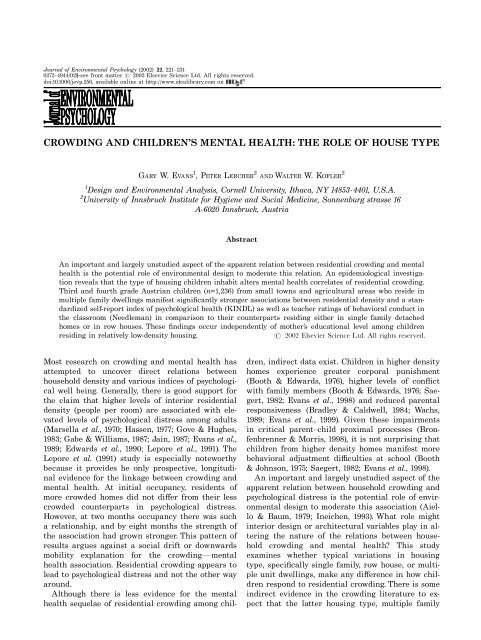
![5 Verben 2 S[1]. 35-44.pdf](https://img.yumpu.com/27096544/1/184x260/5-verben-2-s1-35-44pdf.jpg?quality=85)

